Adjuntas, Puerto Rico
Adjuntas (Spanish pronunciation: [aðˈxuntas]) is a small mountainside municipality in Puerto Rico located central midwest of the island on the Cordillera Central, north of Yauco, Guayanilla and Peñuelas; southeast of Utuado; east of Lares and Yauco; and northwest of Ponce. Adjuntas is spread over 16 wards and Adjuntas Pueblo (the downtown area and the administrative center of the city). Adjuntas is about two hours by car westward from the capital, San Juan. It is the principal city of and comprises the Adjuntas Micropolitan Statistical Area.
Adjuntas | |
|---|---|
Town and Municipality | |
 View of Adjuntas from a nearby mountain. | |
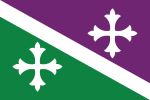 Flag 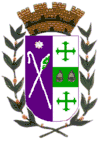 Coat of arms | |
| Nicknames: | |
| Anthem: Adjuntas es mi amor | |
 Location of Adjuntas in Puerto Rico | |
| Coordinates: 18°09′46″N 66°43′20″W | |
| Commonwealth | |
| Founded | August 11, 1815 |
| Founded by | Diego Maldonado |
| Government | |
| • Mayor | Jaime H. Barlucea (PNP) |
| • Senatorial dist. | 5 - Ponce |
| • Representative dist. | 22 |
| Elevation | 1,654 ft (504 m) |
| Population (April 1, 2010[1]) | |
| • Total | 19,483 |
| Demonym(s) | Adjunteños |
| Time zone | UTC−4 (AST) |
| Zip code | 00601, 00631 |
| Major routes[2] | |
| Website | adjuntaspr |
Adjuntas is nicknamed "the Switzerland of Puerto Rico", because of its relatively chilly weather. Many Puerto Rican mountain towns have cooler weather than the rest of the island; Adjuntas is no exception: the average yearly weather is 70 °F (21 °C) (High: 83 °F/28 °C; Low: 58 °F/14 °C).[3] Puerto Rico's lowest temperature were recorded in Adjuntas at 38°F.[4] Its mild climate attracts a good number of island tourists during the summer months. The town has a small hotel named Monte Rio and a good-sized parador, or country inn, called Villa Sotomayor.[5]
Adjuntas' Zip Code, 00601, is the lowest code in the United States zip code system.
History
Although there are petroglyphs and traces of Taíno people in Adjuntas, there is no proof that the region was dominated by a specific cacique. Nearby caciques like Guarionex and Urayoán could have had some control over the area.
According to historian Aurelio Tió, during the Spanish colonization of Puerto Rico in the 16th century, it is believed that a Spanish interpreter called Juan González settled in the region. Also, historian Cayetano Coll y Toste wrote a legend about Spanish people looking for gold in the region of Adjuntas.
As colonization progressed, Adjuntas became part of the San Blas de Illescas (Coamo village),[6] which was founded in 1579 and became the most important settlement in the south. It is believed that the name "Adjuntas" derives from the term of "being close" to Coamo. As population shifted to Ponce, Adjuntas became more linked to that town, and then to Utuado, being a ward of this municipality in 1739.
With 20 families established in the region, the residents of Adjuntas vouched for the settlement to be officially recognized. The town of Adjuntas was then founded in August 11, 1815, with Diego Maldonado being elected as its representative. A city hall and public square were built shortly after.[7]

Adjuntas was one of the main cities where the Anusim, Maranos, and other Sephardi Jews settled. Many of these families were of the Torres, Perez or Peretz, and Bennazar families among others. Berberena and Mozarabes settled there too.
Taíno families from neighboring Utuado can also be found in this area, along with escaped cimarrones, or African slaves, who intermarried with the Taíno. DNA genetic evidence shows that many Africans fled up the Camino Real into the mountains to escape the sugar plantations of Ponce. The Mandinka, Wolof & Fulani mtDNA African haplotype, L1b, is present here. Taíno haplogroups A & C can also be found in this area.
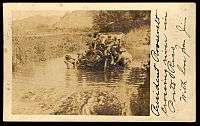
After the mid-19th century, Adjuntas welcomed many immigrants from the Mediterranean islands Corsica and Majorca. Some of them established coffee plantations. During the last decades of the 19th century, the coffee produced in Adjuntas was exported to Europe, United States and even the Vatican.[8]
Adjuntas was proclaimed a "villa", or a first order municipality, by the Spanish Government Monarchy in 1894.[9] Several years after, the town was occupied by the United States Army forces during the Spanish–American War of 1898 and was visited by President Theodore Roosevelt in 1906.[10]
The discovery of rich deposits of copper, gold and other minerals during the 1960s motivated some local community and environmental leaders to oppose the mining. Casa Pueblo, a local community organization settled in Adjuntas, opposed to the mining and advocates for the preservation of natural resources in Puerto Rico.[11][12][13]
Geography

The terrain of Adjuntas is very mountainous due to its location in the Cordillera Central. It borders Utuado in the north and east, Lares and Yauco to the west, and Guayanilla, Peñuelas, and Ponce to the south.[6]
Historian Pedro Tomás de Córdova described the terrain as "high, and mountainous, and very healthy". He also praised the quality of the terrain for agriculture.[14] Adjuntas' highest peak is Monte Guilarte (3,773 ft; 1,150 m),[15] followed by Vaquiñas (3,346 ft; 1,020 m). Guilarte itself is the sixth highest peak in Puerto Rico, and is located in Guilarte State Forest. Córdova also mentioned the water features, describing 26 rivers and 16 creeks that ran through the region.
Hurricane Maria

Hurricane Maria on September 20, 2017 triggered numerous landslides in Adjuntas with the significant amount of rainfall.[16][17]
Bodies of water
The following rivers flow through Adjuntas: Río Cidra, Río Corcho, Rio de la Ciénaga (GNIS ID 1612409), Río Garzas, Río Guilarte, Río las Vacas (GNIS ID 1609475), Río Limaní, Río Saltillo, Río Toro, Río Vacas (GNIS ID 1612618), and Río Yahuecas. There aren't any beaches in Adjuntas given that it is landlocked.[18]
Barrios
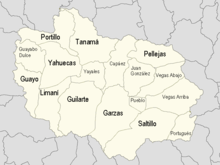
The municipality of Adjuntas is made up of 17 barrios, including the barrio-pueblo.[19][20][21][2]
Sectors
Barrios (which are like minor civil divisions)[22] in turn are further subdivided into smaller local populated place areas/units called sectores (sectors in English). The types of sectores may vary, from normally sector to urbanización to reparto to barriada to residencial, among others.[23][24][25]
Climate
| Adjuntas[3] (Climate - Tropical Rainforest (Af)) | ||||||||||||||||||||||||||||||||||||||||||||||||||||||||||||
|---|---|---|---|---|---|---|---|---|---|---|---|---|---|---|---|---|---|---|---|---|---|---|---|---|---|---|---|---|---|---|---|---|---|---|---|---|---|---|---|---|---|---|---|---|---|---|---|---|---|---|---|---|---|---|---|---|---|---|---|---|
| Climate chart (explanation) | ||||||||||||||||||||||||||||||||||||||||||||||||||||||||||||
| ||||||||||||||||||||||||||||||||||||||||||||||||||||||||||||
| ||||||||||||||||||||||||||||||||||||||||||||||||||||||||||||
Adjuntas features a tropical rainforest climate that borders on a subtropical highland climate. While the town technically features a tropical rainforest climate, due to its high elevation, the climate is noticeably cooler than the norm for this climate category. Summers are warm (83°-85 °F) in the daytime and mild at nighttime (60°-63 °F). Meanwhile, winters are moderately warm with cool temperatures at night. During daytime, high temperatures are around 79 °F (26 °C) in the town and 68 °F (20 °C) in the nearby mountains. Winter night temperatures are between in the 55 °F (13 °C) and 60 °F (16 °C) range, but after cold fronts temperatures can drop down to 45 °F (7 °C).[3]
Demographics
| Historical population | |||
|---|---|---|---|
| Census | Pop. | %± | |
| 1900 | 19,484 | — | |
| 1910 | 16,954 | −13.0% | |
| 1920 | 17,988 | 6.1% | |
| 1930 | 18,075 | 0.5% | |
| 1940 | 22,556 | 24.8% | |
| 1950 | 22,424 | −0.6% | |
| 1960 | 19,658 | −12.3% | |
| 1970 | 18,691 | −4.9% | |
| 1980 | 18,786 | 0.5% | |
| 1990 | 19,451 | 3.5% | |
| 2000 | 19,143 | −1.6% | |
| 2010 | 19,483 | 1.8% | |
| Est. 2016 | 18,314 | [27] | −6.0% |
| U.S. Decennial Census[28] 1899 (shown as 1900)[29] 1910-1930[30] 1930-1950[31] 1960-2000[32] 2010[19] | |||
| Racial - (self-defined) Adjuntas, Puerto Rico - 2010 Census[33] | ||
|---|---|---|
| Race | Population | % of Total |
| White | 18,146 | 93.1% |
| Black/African American | 603 | 3.1% |
| American Indian and Alaska Native | 68 | 0.4% |
| Asian | 5 | 0.0% |
| Native Hawaiian Pacific Islander | 1 | 0.0% |
| Some other race | 411 | 2.1% |
| Two or more races | 249 | 1.3% |
Adjuntas currently has a population of 19,483. This represents a growth of 340, from 19,143 in 2000. Throughout the years, it hasn't shown significant changes, with the highest being 22,556 (1940) and the lowest in the last century being 18,075 (1930).[34][35]
80% of the Per capita income of Adjuntas is a product of agriculture. In 2010, unemployment hit 20.2%. According to mayor, Jaime Barlucea, it decreased to 18.7 in 2011. However, according to the Department of Employment of Puerto Rico, it increased to 21.3.[36]
Economy
Agriculture
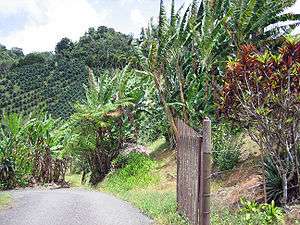
Since its foundation in the 19th century, the production of coffee, sugarcane, small fruits, and cattle have formed the foundation of the economy of Adjuntas. During the middle of the 20th century, however, the production of sugar declined with the arrival of manufacturing industries.[6]
Adjuntas is still considered one of the main producers of coffee in the island, producing 32% of the coffee consumed in the island.[36] Other products produced in Adjuntas are tropical crops such as bananas, citron and peaches.
Industry
During the middle of the 20th century, some manufacturing industries established themselves in town as part of Operation Bootstrap. However, as of 2012, most of them have already closed. One of the last manufacturing companies in town, a military uniforms company, closed in March 2012.[37]
Tourism
Although tourism hasn't been an integral part of the economy of Adjuntas, according to historic records, it has been present since the 19th century. Historian Lidio Cruz Monclóva noted that around 1871, some doctors requested patients to travel to Adjuntas to stay in a hotel called "La Adjunteña". The hotel was the property of C.L. Ginestre, and served both tourists and the sick. Cruz noted that doctors believed the colder temperatures of the town were beneficial to health.[38]
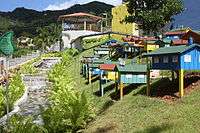
Nowadays, Adjuntas receives approximately 700 tourists per weekend, according to mayor Jaime Barlucea.[37] Most of them want to visit the haciendas established there during past centuries. Some of them are: Hacienda Bareal, Hacienda El Muerto, Hacienda Arbela, and Hacienda Pietri. Other landmarks are Monte Guilarte, and the Inabón waterfall.
Another known tourist stop in Adjuntas is Casa Pueblo, a local museum and cultural institution founded by a group of activists that fought against the copper mine exploitation of the area for decades. Casa Pueblo is responsible for many environmental projects, namely the preservation of hundreds of acres of woods and bodies of water.
However, some residents and businesspeople from Adjuntas maintain that the government has not taken advantage of the many tourist attractions in town, which include three forests, waterfalls, lakes, and many renowned restaurants.[37] One of the projects that has received media coverage is the Castillo de los Niños, built during the mayoralty of Barlucea. Castillo de los Niños is a recreational park resembling a castle, with gazebos.[39][40]
Villa Sotomayor is a parador, featuring ecotourism. Villa Sotomayor features food prepared with local ingredients, from a nearby estate Hacienda Nur.[5]
Special Communities Program
In 2001, law 1-2001 was passed[41] to identify communities with high levels of poverty in Puerto Rico.[42] In 2017, Governor Rosello created a new government agency to work with the Special Communities of Puerto Rico Program.[43][44] Of the 742 places on the list of Comunidades Especiales de Puerto Rico, the following barrios, communities, sectors, or neighborhoods are in Adjuntas: Acueducto neighborhood, Calle del Agua, Guayo barrio, Rullán neighborhood, Saltillo Vaca, Tanamá barrio, and Yahuecas barrio.[45]
Human resources
Education
In all of the island's municipalities, public education is overseen by the Puerto Rico Department of Education. When the United States took control of Puerto Rico from Spain in the aftermath of the Spanish-American War, under the terms of the Treaty of Paris of 1898, there were already six public schools established in Adjuntas. Historian Cayetano Coll y Toste offered a detailed account of each of them, including the number of students, which at the time totaled 402.[46]
As of 2018-2019 the following public schools were operational in Adjuntas:[47][48]
- Domingo Massol is a rural, elementary school located in Saltillo barrio, offering grades K - 6 with about 114 students.
- Domingo Pietri Ruiz is an urban, elementary school offering K - 3 grades with about 425 students.
- Rafael Aparicio Jimenez is an urban, intermediate school offering grades 7 - 9 with about 385 students.[49]
- Hector I Rivera is a rural school located in Yahuecas barrio, offering K - 8 with about 240 students.
- Jose Emilio Lugo is an urban, high school located in Urbanización Cerros, offering grades 10 - 12 with over 600 students.
- Jose B. Barcelo Oliver is a rural school for adults located in Saltillo barrio.
Culture
Events and festivals
Adjuntas is the site of several yearly celebrations and festivals. The most notable are:
- last weekend in February - Festival of the Cold (Festival del Frío), celebrates Adjuntas cool temperatures
- April - The Festival of the Giant (Festival del Gigante)
- May - The Festival of the Citron (Festival de la Cidra)
- August 21 - patron saint festival (Fiestas Patronales) - In Adjuntas the patron saint festival is dedicated to Saint Joachim and Saint Anne.[51][52]
- December - Christmas Festival
Sports
The town has a professional volleyball team called Gigantes de Adjuntas that plays on the LVSM in Puerto Rico.[53][54] The team won a title in 1973.
Transportation
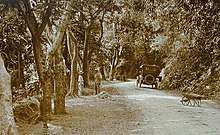
In 1874, General José Laureano Sanz, Governor of Puerto Rico, sponsored a road from Ponce to Arecibo, going across Adjuntas and Utuado. In 1885, it is believed that the road was under construction.[55]
Nowadays, the main road to Adjuntas is PR-10, that connects the cities of Ponce in the south and Arecibo in the north, going across Adjuntas in the center. Before the PR-10 was built, roads like the PR-123, and other small roads were used to reach town.
There is also a small airport in Adjuntas that caters to private airplanes.[56]
Adjuntas has 30 bridges.[57]
Government
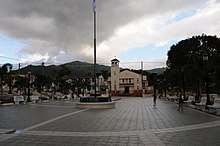
All municipalities in Puerto Rico are administered by a mayor, elected every four years. The current mayor of Adjuntas is Jaime H. Barlucea, of the New Progressive Party (PNP). He was elected at the 2004 general elections in a close election against incumbent Roberto Vera Monroig.[58] Barlucea has been reelected three times since (2008, 2012, and 2016).[59]
The city belongs to the Puerto Rico Senatorial district V, which is represented by two Senators. In 2016, Luis A. Berdiel Rivera and Nelson Cruz, from the New Progressive Party, were elected as District Senators.[60]
Symbols

Coat of Arms
The coat of arms of Adjuntas is divided in two. The left side features a shepherd's staff crossed with a yarnwinder in a purple field. They symbolize the Old Testament patriarchs, representing Saint Joachim and Saint Anne, parents of the Virgin Mary. An eight-pointed star sits above them representing the Virgin.
The right side of the coat of arms is divided in three fields. The upper and lower field have green crosses in white fields. The crosses, known as "flory or fleury" are also present in the symbols of Coamo, because of the relationship between both towns. Two bells lie in the middle field, also a representation of the name of "Adjuntas".
Two coffee branches surround the coat of arms, representing Adjuntas location and its importance in the coffee industry of the island. The castle at the top represents the title of village given to Adjuntas by Spain in 1894.[61]
Flag
The flag of Adjuntas has similar symbolisms. A white diagonal stripe divides the flag in two triangles. The upper one is purple, while the lower one is green. In the middle of each triangle lies a white "cross fleury". The white color symbolizes purity, while purple represents Saint Joachim's cloth and green the nature of the town.[61]
Anthem
The anthem of Adjuntas was written by José Nieves Pérez and is called "Adjuntas, mi amor".[62]
Nicknames
Adjuntas has several nicknames. One is "La ciudad del gigante dormido" ("The city of the sleeping giant"). This is a reference to one of the mountains of the city, which is compared to a "sleeping giant".[63] Another nickname is "La Suiza de Puerto Rico" ("The Switzerland of Puerto Rico") which is a reference to Adjuntas' relatively low temperatures. Adjuntas has an average yearly weather of 70 degrees Fahrenheit.[3] Finally, Adjuntas is also called "La tierra de lagos" ("The land of lakes") because of its many lakes.[5]
Notable Adjunteños
Among the notable Adjunteños are the following:
- Aristides A. Moll Boscana - Poet, writer, translator and politician. He was the first Puerto Rican to write a complete modernista poetry book: Mi misa rosa (1905).[64] In United States he worked as a technical writer for the federal government, as a translator of the first Spanish-language edition of the Journal of the American Medical Association, and as Secretary of the Pan American Sanitary Bureau in Washington, DC, where he edited the Latin American edition of its bulletin. He participated of many Latin American public health conferences, the first World Health Organization conference in Paris, France, and represented El Salvador during the WHO constitutional conference in New York. He wrote many public health related essays and prepared two bilingual (Spanish - English) medical dictionaries and a Spanish medical manual for physicians. He published Aesculapius in Latin America, a history of medicine in the Americas.
- César Luis González - The first Puerto Rican pilot in the United States Army Air Forces and the first Puerto Rican pilot to die in World War II. His name is listed on the "Roll of Honor" of the 314th Troop Carrier Group World War II[65] and Adjuntas has honored his memory by naming a street "Calle Cesar González" after him.
- Norman Maldonado - One of Puerto Rico's leading hematologists and former president of the University of Puerto Rico.[66]
References
- "American FactFinder - Results". factfinder2.census.gov. Retrieved November 19, 2015.
- "Map of Adjuntas at the Wayback Machine" (PDF). Archived from the original (PDF) on 2015-04-17. Retrieved 2018-12-29.
- "Adjuntas Normals". srh.noaa.gov. Archived from the original on 2016-01-12. Retrieved November 19, 2015.
- Se siente el frío navideño en la montaña: Pero, la costa de la isla sigue caliente. Archived 2018-12-18 at the Wayback Machine El Nuevo Dia. 18 December 2018. Accessed 18 December 2018.
- "Gigante seducción en Adjuntas". Primera Hora (in Spanish). 2 December 2018. Archived from the original on 17 August 2019. Retrieved 17 August 2019.
- "Adjuntas Municipality". enciclopediapr.org. Fundación Puertorriqueña de las Humanidades (FPH). Archived from the original on 6 January 2019. Retrieved 14 February 2019.
- Orígenes y Fundación Archived 2012-05-23 at the Wayback Machine on Historia de Adjuntas
- Coffee Growers Try to Revive a Toast of Cafe Society. Archived 2018-12-26 at the Wayback Machine Abby Goodnough. The New York Times. (A version of this article appears in [The New York Times print version] on July 24, 2005, with the headline: "Adjuntas Journal; Coffee Growers Try to Revive a Toast of Cafe Society.") 24 July 2005. Accessed 25 December 2018.
- El Impacto de la Real Cédula de Gracia en Adjuntas en 1815 Archived 2011-09-19 at the Wayback Machine on Interamerican University of Puerto Rico; Martínez Román, José A.
- Roosevelt in Puerto Rico Archived 2013-07-26 at the Wayback Machine on Historia de Adjuntas
- "Casa Pueblo". Archived from the original on 2014-12-07. Retrieved December 5, 2014.
- Bauzá, Nydia (October 27, 2014). "Legislatura aprobará proyecto del Bosque Modelo esta semana". El Nuevo Día. Archived from the original on 2014-12-25. Retrieved December 5, 2014.
- "Inauguran la Escuela Bosque en Adjuntas". El Nuevo Día. August 17, 2013. Archived from the original on 2014-12-25. Retrieved December 5, 2014.
- "Pasajes Históricos del Siglo XIX". Historia de Adjuntas. Archived from the original on 2013-07-26. Retrieved 2012-05-13.
- Calvo Almodóvar, Damarich M. (15 July 2009). "En las entrañas de la Cordillera Central". La Perla del Sur. p. 22. Archived from the original on 2012-05-29. Retrieved November 2, 2011.
- "Preliminary Locations of Landslide Impacts from Hurricane Maria, Puerto Rico". USGS Landslide Hazards Program. USGS. Archived from the original on 2019-03-03. Retrieved 2019-03-03.
- "Preliminary Locations of Landslide Impacts from Hurricane Maria, Puerto Rico" (PDF). USGS Landslide Hazards Program. USGS. Archived (PDF) from the original on 2019-03-03. Retrieved 2019-03-03.
- "Las 1,200 playas de Puerto Rico [The 1200 beaches of Puerto Rico]". Primera Hora (in Spanish). April 14, 2017. Archived from the original on December 12, 2019. Retrieved December 12, 2019.
- Puerto Rico:2010:population and housing unit counts.pdf (PDF). U.S. Dept. of Commerce, Economics and Statistics Administration, U.S. Census Bureau. 2010. Archived (PDF) from the original on 2017-02-20. Retrieved 2019-02-10.
- Picó, Rafael; Buitrago de Santiago, Zayda; Berrios, Hector H. Nueva geografía de Puerto Rico: física, económica, y social, por Rafael Picó. Con la colaboración de Zayda Buitrago de Santiago y Héctor H. Berrios. San Juan Editorial Universitaria, Universidad de Puerto Rico,1969. Archived from the original on 2018-12-26. Retrieved 2019-02-10.
- Gwillim Law (20 May 2015). Administrative Subdivisions of Countries: A Comprehensive World Reference, 1900 through 1998. McFarland. p. 300. ISBN 978-1-4766-0447-3. Retrieved 25 December 2018.
- "US Census Barrio-Pueblo definition". factfinder.com. US Census. Archived from the original on 13 May 2017. Retrieved 5 January 2019.
- "Agencia: Oficina del Coordinador General para el Financiamiento Socioeconómico y la Autogestión (Proposed 2016 Budget)". Puerto Rico Budgets (in Spanish). Retrieved 28 June 2019.
- Rivera Quintero, Marcia (2014), El vuelo de la esperanza: Proyecto de las Comunidades Especiales Puerto Rico, 1997-2004 (first ed.), San Juan, Puerto Rico Fundación Sila M. Calderón, ISBN 978-0-9820806-1-0
- "Leyes del 2001". Lex Juris Puerto Rico (in Spanish). Retrieved 24 June 2020.
- "Adjuntas Normals". San Juan, PR: National Weather Service Weather Forecast Office. Archived from the original on 2011-05-12. Retrieved April 18, 2011.
- "Population and Housing Unit Estimates". United States Census Bureau. Retrieved September 21, 2017.
- "U.S. Decennial Census". United States Census Bureau. Archived from the original on April 26, 2015. Retrieved September 21, 2017.
- "Report of the Census of Porto Rico 1899". War Department, Office Director Census of Porto Rico. Archived from the original on July 16, 2017. Retrieved September 21, 2017.
- "Table 3-Population of Municipalities: 1930, 1920, and 1910" (PDF). United States Census Bureau. Archived (PDF) from the original on August 17, 2017. Retrieved September 21, 2017.
- "Table 4-Area and Population of Municipalities, Urban and Rural: 1930 to 1950" (PDF). United States Census Bureau. Archived (PDF) from the original on August 30, 2015. Retrieved September 21, 2014.
- "Table 2 Population and Housing Units: 1960 to 2000" (PDF). United States Census Bureau. Archived (PDF) from the original on July 24, 2017. Retrieved September 21, 2017.
- "American FactFinder - Results | U.S. Census Bureau". factfinder2.census.gov. Retrieved November 19, 2015.
- Población de Puerto Rico por Municipios Archived 2013-07-26 at the Wayback Machine on CEEPUR
- Censo 2010 Archived 2012-06-03 at the Wayback Machine on ElectionsPuertoRico
- "Radiografía 2012 - Adjuntas". El Nuevo Día. Archived from the original on 2012-04-29. Retrieved 2012-05-11.
- Ruíz Kuilan, Gloria (2012). "Dormida la economía de Adjuntas". El Nuevo Día. Archived from the original on 2012-04-29. Retrieved 2012-05-11.
- "Pasajes Históricos del Siglo XIX - Turismo". Historia de Adjuntas. Archived from the original on 2013-07-26. Retrieved 2012-05-13.
- Castillo de los Niños en Adjuntas Archived 2012-03-24 at the Wayback Machine on NotasBreves
- Adjuntas contará con su propio castillo infantil Archived 2013-07-27 at the Wayback Machine on Primera Hora
- "Leyes del 2001". Lex Juris Puerto Rico (in Spanish). Archived from the original on 14 September 2018. Retrieved 24 June 2019.
- "Comunidades Especiales de Puerto Rico" (in Spanish). 8 August 2011. Archived from the original on 24 June 2019. Retrieved 24 June 2019.
- "Evoluciona el proyecto de Comunidades Especiales". El Nuevo Dia (in Spanish). 24 February 2017. Archived from the original on 24 June 2019. Retrieved 24 June 2019.
- ElVocero.com, Por. "Ya es ley Oficina para el Desarrollo Socioeconómico y Comunitario". El Vocero de Puerto Rico (in Spanish). Archived from the original on 24 June 2019. Retrieved 24 June 2019.
- Rivera Quintero, Marcia (2014), El vuelo de la esperanza:Proyecto de las Comunidades Especiales Puerto Rico, 1997-2004 (Primera edición ed.), San Juan, Puerto Rico Fundación Sila M. Calderón, p. 273, ISBN 978-0-9820806-1-0
- "Adjuntas - Educación antes del 1898". Historia de Adjuntas. Archived from the original on 2017-12-26. Retrieved 2017-12-26.
- "Directorio Comprensivo de Escuelas Públicas, Puerto Rico 2018 | Puerto Rico Government Open Data Portal". data.pr.gov. Archived from the original on 2018-10-04. Retrieved 2020-03-28.
- "Search for Public Schools". National Center for Education Statistics (NCES) Home Page, a part of the U.S. Department of Education. Retrieved 31 March 2020.
- https://www.newsy.com/stories/puerto-rico-schools-stuck-money-delays-much-needed-repairs/
- "Hospital Castañer". Hospital Castañer. Archived from the original on 2017-12-16. Retrieved 2017-12-26.
- Patron Saint Festivals Archived 2012-05-23 at the Wayback Machine on Welcome to Puerto Rico
- Pariser, Harry S. (2003). Explore Puerto Rico, Fifth Edition. San Francisco: Manatee Press. pp. 52–55. Retrieved 10 February 2019.
- Con vida los Gigantes de Adjuntas on Primera Hora; Ayala Gordián, José (November 22, 2011)
- Standing Temporada Regular 2012 Archived 2012-06-02 at the Wayback Machine on Federacion Puertorriqueña de Volibol
- Pasajes Históricos del Siglo XIX - Sobre Caminos Archived 2013-07-26 at the Wayback Machine on Historia de Adjuntas
- Adjuntas Airport Archived 2013-12-20 at the Wayback Machine on Google Maps
- "Adjuntas Bridges". National Bridge Inventory Data. US Dept. of Transportation. Archived from the original on 20 February 2019. Retrieved 19 February 2019.
- Elecciones Generales 2004 - Alcalde de Adjuntas Archived 2012-11-11 at the Wayback Machine on CEEPUR.org
- Elecciones Generales 2008 - Alcalde de Adjuntas Archived 2011-11-20 at the Wayback Machine on CEEPUR
- Elecciones Generales 2016: Escrutinio General Archived 2016-12-21 at the Wayback Machine on CEEPUR
- "Adjuntas - Himno, Bandera y Escudo". adjuntas1.tripod.com. Archived from the original on 2012-05-23. Retrieved November 19, 2015.
- Adjuntas Archived 2013-04-23 at the Wayback Machine on SalonHogar.com
- Adjuntas Archived 2012-06-08 at the Wayback Machine on PRFrogui
- https://www.amazon.com/misa-rosa-Spanish-Aristides-Boscana/dp/1935163515/ref=sr_1_1?s=books&ie=UTF8&qid=1376361151&sr=1-1&keywords=moll+boscana
- "ROLL OF HONOR of the 314th Troop Carrier Group" (PDF). worldwar2pilots.net. Archived from the original (PDF) on March 25, 2012. Retrieved November 19, 2015.
- Wintrobe, Maxwell Myer (1985). Hematology, the blossoming of a science: a story of inspiration and effort. Lea & Febiger. p. 236. ISBN 978-0-8121-0961-0. Archived from the original on 2020-01-04. Retrieved 2016-07-10.
Further reading
- Mi Pueblo Adjuntas, 1992, by Rafael J. Mirabal-Linares
- Entre Fotos y Palabras, 2005 by Rafael J. Mirabal-Linares
- A Gringocua Travels Puerto Rico Adjuntas, 2012 by Greg Boudonck
- Mi misa rosa, 2013, by Arístides A. Moll Boscana, with a preliminary essay by Ramón Luis Acevedo Marrero